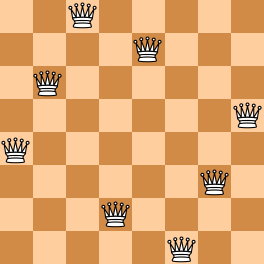The "eight queens puzzle" is the problem of placing eight chess queens on an 8 chessboard so that no two queens threaten each other. Thus, a solution requires that no two queens share the same row, column, or diagonal. The eight queens puzzle is an example of the more general N queens problem of placing N non-attacking queens on an N×N chessboard. (From Wikipedia - "Eight queens puzzle".)
Here you are NOT asked to solve the puzzles. Instead, you are supposed to judge whether or not a given configuration of the chessboard is a solution. To simplify the representation of a chessboard, let us assume that no two queens will be placed in the same column. Then a configuration can be represented by a simple integer sequence (, where Qi is the row number of the queen in the i-th column. For example, Figure 1 can be represented by (4, 6, 8, 2, 7, 1, 3, 5) and it is indeed a solution to the 8 queens puzzle; while Figure 2 can be represented by (4, 6, 7, 2, 8, 1, 9, 5, 3) and is NOT a 9 queens' solution.
 |  | |
|---|---|---|
| Figure 1 | Figure 2 |
Input Specification:
Each input file contains several test cases. The first line gives an integer K (1). Then K lines follow, each gives a configuration in the format "N Q1 Q2 ... QN", where 4 and it is guaranteed that 1 for all ,. The numbers are separated by spaces.
Output Specification:
For each configuration, if it is a solution to the N queens problem, print YES in a line; or NO if not.
Sample Input:
4
8 4 6 8 2 7 1 3 5
9 4 6 7 2 8 1 9 5 3
6 1 5 2 6 4 3
5 1 3 5 2 4
Sample Output:
YES
NO
NO
YESN皇后问题,我们给定K个测试用例,给定N皇后,(i, N)为皇后坐标,查询给定用例皇后不在同行,同列,同斜线,如果满足,则输出YES,否则输出NO
#include <iostream> #include <vector> #include <unordered_map> using namespace std; int main() { int K, N, tmp; scanf("%d", &K); while(K--) { scanf("%d", &N); vector<pair<int, int>> v; bool no = false; for(int c = 0; c < N; c++) { scanf("%d", &tmp); for(auto x: v) { if(x.first == c || x.second == tmp || ((x.first - c) == (x.second - tmp) && (x.first - c) * (x.second - tmp) > 0)) no = true; } v.push_back({c, tmp}); } printf("%s ", no ? "NO" : "YES"); } return 0; }